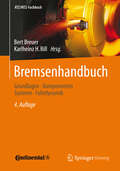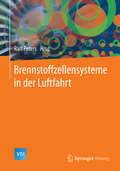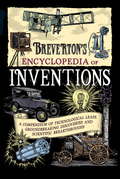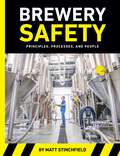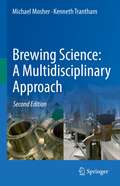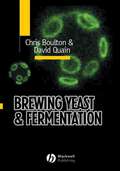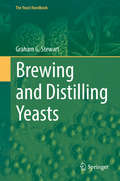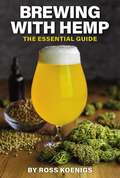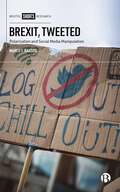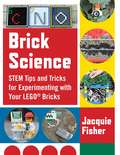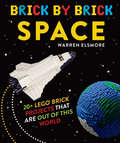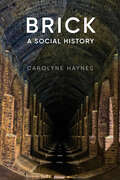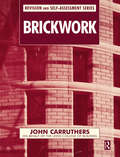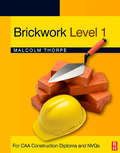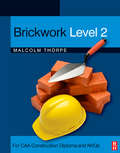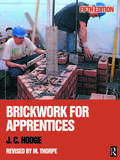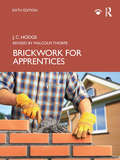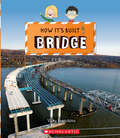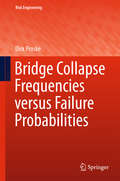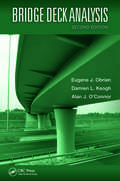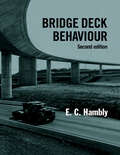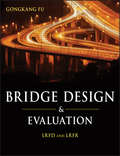- Table View
- List View
Bremsenhandbuch: Grundlagen, Komponenten, Systeme, Fahrdynamik (ATZ/MTZ-Fachbuch)
by Bert Breuer Karlheinz H. BillDas Bremsenhandbuch ermöglicht einen tiefen Einblick in den heutigen Stand, die Potentiale und die zukünftige Entwicklung von Kraftfahrzeugbremsanlagen. Mikroelektronik und Mechatronik haben das technische Potential und die Funktionalität von Bremsanlagen enorm gesteigert. Hydraulisch, elektrohydraulisch oder elektromechanisch betätigte Bremsen und die gesamte Bremsanlage mit all ihren Komponenten sind ein unverzichtbarer Teil des heute bereits erreichten bzw. zukünftig noch möglichen Niveaus der Sicherheit, der Fahrerassistenz und der Unfallvermeidung. Das Bremsenhandbuch behandelt umfassend Grundlagen, Anforderungen, Auslegung, Simulation, Komponenten, Systeme, Betriebsverhalten und Funktionen im modernen Fahrzeug. Es berücksichtigt dabei Personenwagen, Nutzfahrzeuge, Anhänger, Schienenfahrzeuge, geländegängige Rad- und Kettenfahrzeuge, Motor- und Fahrräder sowie Rennfahrzeuge und Flugzeuge. Diese dritte Auflage wurde gründlich überarbeitet, aktualisiert und z.B. durch neue Kapitel zu Bremssystemen von Schienenfahrzeugen, mechatronischen Systemen, mechanischen Bremsen in Industrieanlagen oder Bremsen mit nichtmetallischen Bremsscheiben erheblich erweitert. Einheitliche Formelzeichen wurden für alle Kapitel eingeführt.
Brennstoffzellensysteme in der Luftfahrt (VDI-Buch)
by Ralf PetersDer Einsatz von Brennstoffzellensystemen im Flugzeug bietet die M#65533;glichkeit, die Funktionen Strom, Wasser- und Inertgaserzeugung mit Hilfe eines einzigen Systems zu gew#65533;hrleisten, Hilfssysteme (Wassertanks, die konventionelle APU und das FTIS) k#65533;nnen ebenso entfallen wie die zus#65533;tzliche Speicherung von Wasser. Generatoren und Batterien k#65533;nnen kleiner dimensioniert werden. Diese Ma#65533;nahmen verringern den Kraftstoffverbrauch, erh#65533;hen die Gesamteffizienz eines Flugzeuges und erm#65533;glichen einen emissionsarmen Betrieb von Flugzeugen im Flug und besonders am Boden. Die Autoren vergleichen Aspekte bei der Nutzung heutiger und zuk#65533;nftiger Kraftstoffe f#65533;r Brennstoffzellen in der Luftfahrt. Die Eigenschaften geeigneter Brennstoffzellentypen werden beschrieben und analysiert, es wird dabei dargestellt warum der Brennstoffzellentyp HT-PEFC besonders geeignet ist und welche Herausforderungen damit verbunden sind. Technische Entwicklungen, wie die HT-PEFC Stackentwicklung, die der Komponenten des Brenngaserzeugungssystems und der Aufbau und der Test eines 5 kWe HT-PEFC Gesamtsystems werden beschrieben. Das Buch schlie#65533;t mit der Betrachtung von Brennstoffzellensystemen als Bestandteil eines multifunktionalen Systems und dem Ausblick auf zuk#65533;nftige Anwendungen in der Luftfahrttechnik.
Breverton's Encyclopedia of Inventions
by Terry BrevertonInvention and innovation are what distinguish the human race from all of the other species on Earth. Throughout history the imagination and pioneering spirit of human kind has compelled us to question why we do things in a certain way and, more importantly, how we can do things better. Celebrating the ingenuity, creativity and resourcefulness that has led to some of the most amazing technological leaps through the ages, Breverton's Encyclopedia of Inventions examines the key innovations and breakthroughs of all time and the genius behind them.Starting with the building of the pyramids in ancient Egypt and the discovery of the solar system, moving through surgery, dynamite and rockets, to modern technology such as the smart card and genetic engineering, Terry Breverton springs many surprises. He uncovers fascinating and little-known facts: for example, that Price, not Fleming, discovered penicillin; that Swan, not Edison invented the electric light, and that Wallace, not Darwin first advanced the theory of evolution. Tracing the sheer persistence of brilliant men and women across the globe, who fought the prevailing ideas of their times and advanced technology, Breverton's Encyclopedia of Inventions will inspire anyone interested in the history and developments that have changed our lives and shaped our planet's future.
Breverton's Encyclopedia of Inventions: A Compendium of Technological Leaps, Groundbreaking Discoveries and Scientific Breakthroughs that Changed the World
by Terry BrevertonInvention and innovation are what distinguish the human race from all of the other species on Earth. Throughout history the imagination and pioneering spirit of human kind has compelled us to question why we do things in a certain way and, more importantly, how we can do things better. Celebrating the ingenuity, creativity and resourcefulness that has led to some of the most amazing technological leaps through the ages, Breverton's Encyclopedia of Inventions examines the key innovations and breakthroughs of all time and the genius behind them. Starting with the building of the pyramids in ancient Egypt and the discovery of the solar system, moving through surgery, dynamite and rockets, to modern technology such as the smart card and genetic engineering, Terry Breverton springs many surprises. He uncovers fascinating and little-known facts: for example, that Price, not Fleming, discovered penicillin; that Swan, not Edison invented the electric light, and that Wallace, not Darwin first advanced the theory of evolution. Tracing the sheer persistence of brilliant men and women across the globe, who fought the prevailing ideas of their times and advanced technology, Breverton's Encyclopedia of Inventions will inspire anyone interested in the history and developments that have changed our lives and shaped our planet's future.
Breverton's Encyclopedia of Inventions: A Compendium of Technological Leaps, Groundbreaking Discoveries and Scientific Breakthroughs that Changed the World
by Terry BrevertonInvention and innovation are what distinguish the human race from all of the other species on Earth. Throughout history the imagination and pioneering spirit of human kind has compelled us to question why we do things in a certain way and, more importantly, how we can do things better. Celebrating the ingenuity, creativity and resourcefulness that has led to some of the most amazing technological leaps through the ages, Breverton's Encyclopedia of Inventions examines the key innovations and breakthroughs of all time and the genius behind them. Starting with the building of the pyramids in ancient Egypt and the discovery of the solar system, moving through surgery, dynamite and rockets, to modern technology such as the smart card and genetic engineering, Terry Breverton springs many surprises. He uncovers fascinating and little-known facts: for example, that Price, not Fleming, discovered penicillin; that Swan, not Edison invented the electric light, and that Wallace, not Darwin first advanced the theory of evolution. Tracing the sheer persistence of brilliant men and women across the globe, who fought the prevailing ideas of their times and advanced technology, Breverton's Encyclopedia of Inventions will inspire anyone interested in the history and developments that have changed our lives and shaped our planet's future.
Brewery Safety: Principles, Processes, and People
by Matt StinchfieldBrewers of all sizes should uphold the value of safety alongside their edgy brands and creative and carefully crafted beers and other beverages. It's the responsibility of all brewery employees to assess hazards, learn how to control or eliminate them, and to document and train each other on the safest ways to perform tasks. It's not just about government regulation, but it is also about making your brewery the best brewery possible—for your beer, your staff, and your visitors. Breweries face hazards that can be divided into physical, chemical, biological, ergonomic, and psychosocial hazards. Learning to address these aspects of safety to ensure a safe product and working environment is paramount. From physical trauma to chemical irritations, biological hazards to psychosocial hazards, Brewery Safety explores in-depth how to think about and avoid these hazards. Brewers will learn to evaluate, educate, and execute safety conscious measures to ensure that the working environment, welfare of staff, and the quality of the product are first and foremost.
Brewing Science: A Multidisciplinary Approach
by Michael Mosher Kenneth TranthamThis updated text collects all the introductory aspects of beer brewing science into one place for undergraduate brewing science courses. This expansive and detailed work is written in conversational style, walking students through all the brewing basics from the origin and history of beer to the brewing process to post-brew packaging and quality control and assurance. As an introductory text, this book assumes the reader has no prior knowledge of brewing science and only limited experience with chemistry, biology and physics. The text provides students with all the necessary details of brewing science using a multidisciplinary approach, with a thorough and well-defined program of in-chapter and end-of-chapter problems. As students solve these problems, they will learn how scientists think about beer and brewing and develop a critical thinking approach to addressing concerns in brewing science. As a truly comprehensive introduction to brewing science, Brewing Science: A Multidisciplinary Approach, Second Edition walks students through the entire spectrum of the brewing process. The different styles of beer, the molecular makeup and physical parameters, and how those are modified to provide different flavors are listed. All aspects of the brewery process, from the different setup styles to sterility to the presentation of the final product, are outlined in full. All the important brewing steps and techniques are covered in meticulous detail, including malting, mashing, boiling, fermenting and conditioning. Bringing the brewing process full circle, this text covers packaging aspects for the final product as well, focusing on everything from packaging technology to quality control. Students are also pointed to the future, with coverage of emerging flavor profiles, styles and brewing methods. Each chapter in this textbook includes a sample of related laboratory exercises designed to develop a student’s capability to critically think about brewing science. These exercises assume that the student has limited or no previous experience in the laboratory. The tasks outlined explore key topics in each chapter based on typical analyses that may be performed in the brewery. Such exposure to the laboratory portion of a course of study will significantly aid those students interested in a career in brewing science.
Brewing Yeast and Fermentation
by Christopher Boulton David QuainNow Available for the First Time in Paperback!This unique volume provides a definitive overview of modern and traditional brewing fermentation. Written by two experts with unrivalled experience from years with a leading international brewer, coverage includes all aspects of brewing fermentation together with the biochemistry, physiology and genetics of brewers' yeast. Brewing Yeast and Fermentation is unique in that brewing fermentation and yeast biotechnology are covered in detail from a commercial perspective.Now available for the first time in paperback, the book is aimed at commercial brewers and their ingredient and equipment suppliers (including packaging manufacturers). It is also an essential reference source for students on brewing courses and workers in research and academic institutions.Definitive reference work and practical guide for the industry.Highly commercially relevant yet academically rigorous.Authors from industry leading brewers.
Brewing and Distilling Yeasts (The Yeast Handbook)
by Graham G. StewartThis book is an overview considering yeast and fermentation. The similarities and differences between yeasts employed in brewing and distilling are reviewed. The implications of the differences during the production of beer and distilled products (potable and industrial) are discussed. This Handbook includes a review of relevant historical developments and achievements in this field, the basic yeast taxonomy and biology, as well as fundamental and practical aspects of yeast cropping (flocculation), handling, storage and propagation. Yeast stress, vitality and viability are also addressed together with flavor production, genetic manipulation, bioethanol formation and ethanol production by non-Saccharomyces yeasts and a Gram-negative bacterium. This information, and a detailed account of yeast research and its implications to both the brewing and distilling processes, is a useful resource to those engaged in fermentation, yeast and their many products and processes.
Brewing with Hemp: The Essential Guide (Brewing with Cannabis)
by Ross KoenigsBrewing with Hemp: The Essential Guide explores the Cannabis sativa plant from a brewer&’s perspective. Explore the role of foliage and flowers, seeds, fiber, stems, and roots in product development. Learn the science, methods, and techniques for infusing hemp (containing less than 0.3% THC), hemp flavors, and cannabinoids into beverages. Solubilizing shelf stable cannabinoids in beverages, hemp additions at traditional brewing stages, and quality and legal compliance are all discussed. This book navigates the science of cannabis and teaches brewers how to best use hemp to apply its unique aromas to beer. Discover the use of terpenes, create a tincture, or experiment with new recipes using hemp as an ingredient. Readers will learn how to navigate the shifting legal landscape as hemp becomes more acceptable and accessible. This forward-looking book weaves together familiar topics within the study of beer and brewing and applies it to the vast and fascinating world of hemp as an ingredient in beer.
Brexit, Tweeted: Polarization and Social Media Manipulation
by Marco BastosDissecting 45 million tweets from the period that followed the Brexit referendum, this book presents an extensive analysis of social media manipulation. The book examines emerging changes in partisan politics, nationalist and populist values, as well as broader societal changes that are feeding into polarization and echo-chamber communication. It pulls the curtain back on the techniques employed to interfere with, and potentially distort, the public discussion. Making complex data accessible to non-technical audiences, this unique post-mortem of the Brexit referendum contributes to our understanding of social media disinformation in the UK and beyond.
Brick Science: STEM Tips and Tricks for Experimenting with Your LEGO Bricks—30 Fun Projects for Kids!
by Jacquie FisherBuild your way through thirty fantastic STEM experiments, brick by brick! Fun projects that are perfect for fans of LEGO Masters and science subjects! Does your young scientist love LEGOs? Then this is the book for them! Contained within these pages is an assortment of experiments and activities to teach your child all about Science and STEM subjects using LEGO bricks. In Brick Science, various aspects of STEM will be introduced to your creative learner through over thirty exciting and innovative ways of using LEGO bricks. Your child will be exposed to important lessons about chemistry, paleontology, the animal kingdom, and more, all while thinking that they&’re just playing with LEGOs! This fun-filled book contains experiments and ideas for exploring subjects, such as: BiologyChemistryDinosaursEarth SciencePhysicsSpaceWeatherAnd More! The lessons that your child will learn from these experiments will stick with them for years to come, encouraging them to learn, explore, and one day possibly become a scientist themselves. With Brick Science, both you and your young LEGO-lover will be excited to learn about science, nature, and the world around us!
Brick by Brick Space: 20+ LEGO Brick Projects That Are Out of This World
by Warren ElsmoreFrom a master LEGO builder comes twenty easy-to-build space projects using nothing but LEGO bricks!What's better than space or building with LEGO bricks? Building amazing space projects out of your LEGO bricks, of course! Brick by Brick Space provides more than twenty-five amazing projects to build with your LEGO bricks. Follow the easy step-by-step instructions to create space stations, satellites, planets, rocket ships, and more. Scattered throughout are fun and fascinating facts about space exploration and the various objects that are orbiting our world. This is a must-have book for any space enthusiast or LEGO lover.
Brick: A Social History
by Carolyne HaynesBricks – such small and seemingly uninteresting things – have helped to build the way we live as society has evolved, from the feudal system of early Britain right up to today. Originally very expensive, bricks were only used by those who could afford them. This gradually changed with the Great Fire of London in 1666 when legislation decreed that the city must be rebuilt with non flammable materials, and bricks came into their own. A few centuries later bricks formed the infrastructure of industrial Britain as the need for canals and railways grew. But bricks are also associated with some of the worst slums this country has ever known, with poor bricks and sandy mortars indirectly causing misery for thousands of people. Our love affair with bricks continues today, with exposed brickwork being used to decorate both exteriors and interiors. But how are bricks made? What are they made of? Who made them and how have they changed through time? In Brick Carolyne Haynes answers these questions and reveals the surprising social history of bricks in Britain.
Brickwork
by John CarruthersBrickwork allows the reader to develop their understanding of key subjects by completing the numerous exercises and tests, including multiple choice questions. In addition, each topic begins with a summary of key facts and figures, making this an ideal course text based round core information and assessments rather than reading an extended text. The coverage includes health and safety and basic calculations as well as the technical and practical aspects of brickwork. All students of bricklaying will find this a stimulating and useful revision aid.
Brickwork Level 1
by Malcolm ThorpeAs part of their everyday work bricklayers must be able to interpret technical documents, understand the properties of various mortars/building materials, and understand the basics of health and safety on site. Brickwork Level 1 is in full colour, and has been tailored to match Level 1 of both the Construction Alliance Awards Diplomas in Bricklaying and the Trowel Occupations NVQs. Written by Malcolm Thorpe, who acted as a CITB adviser and was involved in the draughting of the Intermediate Construction Award syllabus (bricklaying route), Brickwork Level 1 matches the latest industry-based requirements and technical developments in the field, including recent changes to the Building Regulations. This text is an essential reference for qualified bricklayers and other professionals working in the construction industry, as well as NVQ students wishing to embark on a career in bricklaying.
Brickwork Level 2
by J. C. Hodge Malcolm ThorpeAs part of their everyday work bricklayers must be able to interpret technical documents, understand the properties of various mortars/building materials, and understand the basics of health and safety on site. Brickwork Level 2 has been adapted from John Hodge’s classic Brickwork for Apprentices - the established textbook on brickwork for generations of bricklayers. Now in full colour, this new book has been tailored to match Level 2 of both the Construction Alliance Awards Diplomas in Bricklaying and the Trowel Occupations NVQs. Written by Malcolm Thorpe, who acted as a CITB adviser and was involved in the draughting of the Intermediate Construction Award syllabus (bricklaying route), Brickwork Level 2 matches the latest industry-based requirements and technical developments in the field, including recent changes to the Building Regulations. This text will remain an essential reference for qualified bricklayers and other professionals working in the construction industry, as well as NVQ students wishing to embark on a career in bricklaying.
Brickwork Level 3
by Malcolm ThorpeAs part of their everyday work bricklayers must be able to interpret technical documents, understand the properties of various mortars/building materials, and understand the basics of health and safety on site. Brickwork Level 3 has been adapted from John Hodge’s classic Brickwork for Apprentices - the established textbook on brickwork for generations of bricklayers. Now in full colour, this new book has been tailored to match Level 3 of both the Construction Alliance Awards Diplomas in Bricklaying and the Trowel Occupations NVQs. Written by Malcolm Thorpe, who acted as a CITB adviser and was involved in the draughting of the Intermediate Construction Award syllabus (bricklaying route), Brickwork Level 3 matches the latest industry-based requirements and technical developments in the field, including recent changes to the Building Regulations. This text will remain an essential reference for qualified bricklayers and other professionals working in the construction industry, as well as NVQ students wishing to embark on a career in bricklaying.
Brickwork for Apprentices
by J. C. Hodge Malcolm ThorpeBrickwork for Apprentices has been the established reference on brickwork for generations of bricklayers. Continuously in print since 1944, John Hodge’s classic text has now been fully revised in its fifth edition by Malcolm Thorpe – who acted as a CITB Advisor and was involved in the draughting of the Intermediate Construction Award syllabus (bricklaying route) – to cover the brickwork craft-related units of the latest Construction Awards and related Trowel Occupations NVQs from CITB / City & Guilds at Levels 2 and 3.The fifth edition incorporates extended coverage on the relatively new area of thin joint systems, to match the latest industry-based requirements and technical developments in the field. Content has been brought fully in line with recent changes to the Building Regulations, ensuring that this text will remain an essential reference for qualified bricklayers and other professionals working in the construction industry, as well as NVQ students new to the industry and wishing to embark on a career in bricklaying.A new feature in this edition is the inclusion of multiple choice questions at the back of the book, matched to the current NVQ requirements, to provide students of the CITB / City & Guilds Trowel Occupations NVQs with essential practice and revision for exam preparation.
Brickwork for Apprentices
by Malcolm Thorpe J.C. HodgeExpanded and edited by Malcolm Thorpe, a former CITB Advisor, this latest edition incorporates all the latest industry-based requirements and technical developments in the construction industry. A new feature is the e-resource facility that includes multiple choice questions and answers, short oral questions and answers, and practical competency checks with marking schemes. These are all matched to current programmes, providing students with essential practice and revision for exam preparation. A classic text, Brickwork for Apprentices has been the established reference on brickwork for generations of bricklayers. Continuously in print since 1944, John Hodge’s classic text has now been revised in its sixth edition and brought fully in line with the latest Building Regulations and requirements for City & Guilds courses. This is an essential text for qualified bricklayers and other professionals working in construction, as well as students new to the industry and wishing to embark on a career in bricklaying.
Bridge (How It's Built)
by Vicky FranchinoKids are fascinated by how things are constructed, especially big things!This brand-new STEM (science, technology, engineering, and mathematics) series will take readers on visits to various work sites so they can see exactly How It’s Built! Kids will follow along as a small group of fictional characters get to find out exactly what it takes to build things that they probably see all the time, like bridges, houses, boats, and cars, to things that they might dream of being inside, like skyscrapers and rockets.
Bridge Collapse Frequencies versus Failure Probabilities (Risk Engineering)
by Dirk ProskeThis monograph provides a comparative study between failure probabilities and collapse frequencies in structural bridge engineering. The author presents techniques to resolve and extend the limitations of both parameters, taking also into account the time dependency of both parameters. The book includes available data and case studies and thus presents patterns to identify potential weaknesses and challenges in bridge maintenance. The target audience primarily comprises practicing engineers in the field of bridge engineering, but the book may also be beneficial for academic researchers alike.
Bridge Deck Analysis
by Alan O'Connor Eugene J. Obrien Damien KeoghCaptures Current Developments in Bridge Design and MaintenanceRecent research in bridge design and maintenance has focused on the serviceability problems of older bridges with aging joints. The favored solution of integral construction and design has produced bridges with fewer joints and bearings that require less maintenance and deliver increased
Bridge Deck Behaviour
by E C HamblyThis book describes the underlying behaviour of steel and concrete bridge decks. It shows how complex structures can be analysed with physical reasoning and relatively simple computer models and without complicated mathematics.
Bridge Design and Evaluation
by Gongkang FuA succinct, real-world approach to complete bridge system design and evaluationLoad and Resistance Factor Design (LRFD) and Load and Resistance Factor Rating (LRFR) are design and evaluation methods that have replaced or offered alternatives to other traditional methods as the new standards for designing and load-rating U.S. highway bridges. Bridge Design and Evaluation covers complete bridge systems (substructure and superstructure) in one succinct, manageable package. It presents real-world bridge examples demonstrating both their design and evaluation using LRFD and LRFR. Designed for a 3- to 4-credit undergraduate or graduate-level course, it presents the fundamentals of the topic without expanding needlessly into advanced or specialized topics.Important features include:Exclusive focus on LRFD and LRFRHundreds of photographs and figures of real bridges to connect the theoretical with the practicalDesign and evaluation examples from real bridges including actual bridge plans and drawings and design methodologiesNumerous exercise problemsSpecific design for a 3- to 4-credit course at the undergraduate or graduate levelThe only bridge engineering textbook to cover the important topics of bridge evaluation and ratingBridge Design and Evaluation is the most up-to-date and inclusive introduction available for students in civil engineering specializing in structural and transportation engineering.
